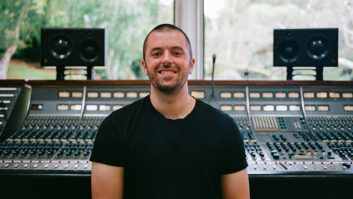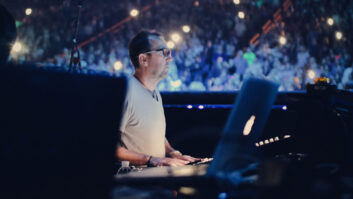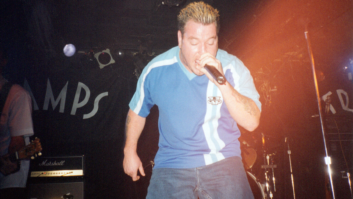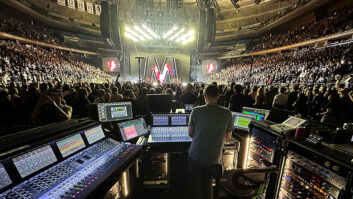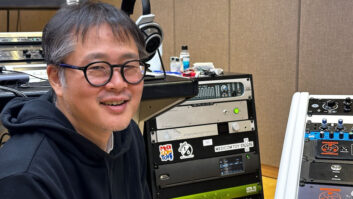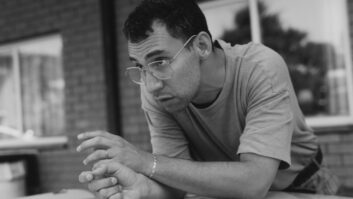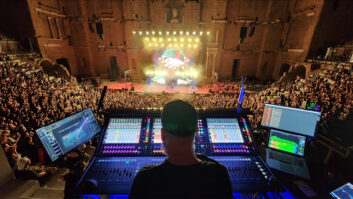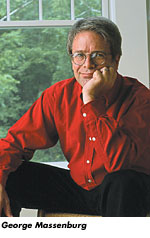
So what’s the big deal? With automatic tuning devices,
nondestructive digital editing, multitracking and effects, why worry
about the vocal sound? These days, you can fix anything, right? Well,
actually, wrong. The vocal is the heart and soul of a song and, unless
you’re working on an instrumental, the whole reason for a song’s
existence. Singers are — or should be — artists. And though
it’s true that some artists need a lot of help, hopefully, you’ll get
to work with the ones who just need you to capture them at their best.
Sound easy? It’s not.
Remember, you’re working with artists. And sometimes that puts an
engineer in the hot seat for a direct injection of intense artistic
personality. At their most vulnerable — when they’re reaching
deep inside for a great performance — artists can be very touchy.
The job is to smooth the way, get them recorded and make sure that they
sound fabulous. For some insight, Mix rounded up a batch of
experts and asked them for opinions, both philosophical and technical,
on the art of recording vocals.
GEORGE MASSENBURG
Know
It’s no secret that George Massenburg has an obsession with sonic
transparency. Fortunately, he’s worked with singers who merit it,
including Linda Ronstadt, Aaron Neville, James Taylor, and Earth, Wind
& Fire. Massenburg’s vocal setup is specific and, not surprisingly,
uses a lot of GML (George Massenburg Labs) equipment. “My feeling
on equipment,” he states, “is that whatever you use,
you need to know it very well. I mainly use my mic pre’s; I know their
strengths and weaknesses. More often than not, what I’m reaching for in
vocals is story, and that’s subtle. I want more of the acoustic sound
and its rich detail so I can choose what to accentuate.”
How a singer hears himself or herself is, of course, crucial.
“Actually,” Massenburg comments, “it’s dealing with
the perception of how they hear themselves. If you have the
vocal hot, you can sometimes push a vocalist a little flatter. If it’s
light, the vocalist will sometimes sing a little sharper. Getting the
vocal placed in a soundscape in the ‘phones definitely contributes to
what texture a vocalist chooses. Sometimes, this soundscape is
different from the mix you want in the speakers. The mix in the ‘phones
wants to flatter the vocalist into thinking that this artificial,
chaotic studio environment is one in which they can sing without
embarrassing themselves. That can be a huge task.”
If a song’s emotion is affected by the mix, it follows that the
responsibility to find the right emotion often falls on the engineer or
producer. “You may want to compress a piano to have it ring a
certain way against the vocal,” Massenburg elaborates.
“Usually, you want to compress the vocal to have it fit better
with the piano, guitar or other tuning instrument. The other thing you
have to keep track of is that — in the best songs, anyway —
there are elements that conflict with each other and elements that
blend: the theme and things working with it and against it. The
textures and timbral balances an engineer reaches for affect all of
those elements.”
If a singer prefers a certain mic, Massenburg puts it up first,
along with his Neumann U67 (with Stephen Paul 0.7-micron capsule), a
Brauner VM1 or a Sanken CU-44X. The contenders are set up side by side
for auditioning, most often (ahem) through a GML mic pre (occasionally
through a Mastering Lab or Great River), GML EQ and GML compressor into
a dB Technologies A/D converter. That kind of mic comparison can be
subtle; the artist’s participation is essential. “The hardest
thing in the studio is listening,” Massenburg states, “and,
if possible, listening from outside your prejudices, like when a
vocalist challenges your ideas on pitch and phrasing.”
That brings up the dilemma of knowing what you’re listening for.
“If you don’t know where your mix is going, you can paint
yourself into a corner by just farting around with cool, seductive
technology,” Massenburg agrees. “If you make bad choices on
your original tracks, they’re pretty hard to reverse. Even if you’ve
kept good notes — and you should — if you’ve added
aggressive EQ, then on top of that heavy compression, you can get in a
lot of trouble. So I’ll choose to record relatively clean. I’ll put the
‘jizz’ just in the monitor path. Or, I’ll record it on
another track.”
On recent sessions for a Verve Records album of jazz standards,
Massenburg recorded Ronstadt with two vocal mics concurrently,
comparing his vintage 67 (which, combined with “a lot of
compression,” is what Ronstadt is used to hearing in her ‘phones)
to more recent mics. The second chain had far less compression, less
high-frequency EQ and less of the natural distortion provided by the
67: one of the things, according to Massenburg, Ronstadt likes about
it. “When she goes loud, it distorts with a flattering kind of
saturation that sounds like a passionate vocalist sounds,” he
explains. “That’s a cue for her, and that’s okay. But I didn’t
want to be locked into it, so we had both.”
Words of wisdom? “Know your gear inside and out,”
Massenburg emphasizes. “It’s okay if you’re insecure; we’re all
insecure. Just never let anybody else in the studio see it! Having just
a few pieces you know well will give you confidence in what you’re
hearing.”
And the big picture? “It’s important to always state very
clearly what’s true. That’s different from always saying what you
think. You want to say what you hear clearly and honestly, and at the
same time, let the artist and producer know they’re in charge and that
you’ll do whatever they want. Your job is to help the artist arrive at
that point where they can explore the muse, those tiny voices that tell
them what to do. For the artist — and for the engineer —
it’s about finding the story and what’s there to be said.”

JIMMY DOUGLASS
Going
Long before Jimmy Douglass was legally old enough to work, he was
hanging out at Atlantic Records’ New York studios, learning classic
techniques from engineering legends like Tom Dowd. These days, he
applies that experience to the engineering battlefield of hip hop,
where, in Manhattan, Miami and L.A., he plies his trade with such
Platinum artists and producers as Missy Elliott, Timbaland and
Jay-Z.
“My whole pace has changed,” he admits, “because
of the technology and the way people are working in the hip hop genre.
They don’t take the time to explore different sounds for different
singers. The idea is king, and they just want to get the ideas
down.”
Frequently accommodating a rapid succession of singers and/or
rappers with little time to switch gear, Douglass has settled on a
basic setup: “A nice [Neumann U] 87, limited just enough to help
me out a little bit. The 87 is one of the most neutral mics around.
Most of them sound pretty good, and if you have problems — if
it’s murky or the level’s not coming in properly — you’ll hear it
right away.”
Adding to the challenge are singers who prefer to work in darkness,
meaning — along with no written lyrics — no visual cues.
“When I was a kid, I’d watch Aretha,” Douglass recalls.
“She’d rehearse a song once or twice; everyone knew what was
going to happen. Daryl Hall, a very dynamic singer, had characteristic
movements he made when he was getting ready to hit a high note. These
days, people don’t tell me what they’re going to be singing. They just
do it.
“It’s all in the moment. You may be set up perfectly, in the
‘phones and on the mic, for a lead vocal, when suddenly, somebody shows
up to do the rap. Right now. Okay, I could have two mics set up and
think I’ve got it covered, but then somebody else shows up who has a
little ad lib part to do. Right now. It’s much easier to have one mic
and basically go for it. I’ll tend not to really EQ things going in, so
I can re-create more easily later. Keeping things flat is key to
keeping speed.”
For working hip hop-style, Pro Tools is, Douglass admits, “a
godsend. When they’re writing on the spot, it really helps that when I
punch in, it’s nondestructive. I can move things around later or put EQ
on a tiny part to make it match up. Or take pops: It’s easy to go to
the exact part of a word, put in a filter or EQ out below 100 [Hz],
then fade in on the word instead of having a sharp attack.”
Douglass uses either the onboard Neve VR preamp, a Neve 1073 or a
Focusrite, with a blackface UREI 1176, generally set “with fast
attack and slow release, so it’s more limiting than compressing. The
meter doesn’t move very much. Hopefully, I’ve got the level set so the
1176 will grab serious peaks. I used to keep marks on [the limiter] to
indicate levels, but now I don’t even bother. We get going so fast, I
just do things on-the-fly.”
Multiple vocalists in rapid succession raise havoc with headphone
mixes. “I try to make it so that the headphones and the mic are
not the issue, and all anybody has to do is perform. The best way to do
that is to leave things, in general, flat. Most people will fall into
the same sound zone, and the overall volume is something that I play
with; some people are sensitive and some like to be tranced out by the
volume.”
Having the experience to know what’s fixable and what isn’t gives
Douglass an edge. “If I think what’s happening really isn’t cool,
I have a couple of cards to play that will change the course of a
song,” he says with a laugh. “Every now and then, I’ll say,
‘This is the thing that’s worth it,’ and I’ll go the whole
nine until we take the time and get it right.”

GARY PACZOSA
Recording
Gary Paczosa works with such singing royalty as Dolly Parton, the
Dixie Chicks and Alison Krauss. These women know the value of a good
engineer; Parton has done 10 albums with Paczosa, and when I happened
to phone during a session, Krauss jumped on the phone to detail what
makes him a vocalist’s favorite.
“Gary makes it sound great,” she comments. “He
also brings me confidence. That’s priceless. It’s pretty exposing to do
this, but with Gary, I feel completely supported. He’s a perfectionist.
He tells you when it’s great and when he doesn’t think it sounds so
good. But by being interested and listening, and having a real love for
music, he sets the atmosphere. He makes me want to do a better job than
I have ever done before.”
“It takes great courage to go out in the studio and, in
effect, pull your pants down in front of everybody,” Paczosa
says. “They know that I’m their best ally. I’m going to have
endless patience, and I’m honest. It’s a fine line to walk: to keep
people encouraged but to let them know exactly what’s going on. Nobody
wants to be bullshitted through the process and then hate what they
hear during playback.”
To create the all-important listening environment, in the room and
in the ‘phones, Paczosa uses baffles to control early room reflections
on loud vocals, chooses reverbs without predelay or early reflections,
and rolls “a little top off [reverbs] for warmth. It doesn’t
sound very wet, and they don’t hear the artificial reverb artifacts,
but they’re in a nice ambient space.”
Most artists get either a stereo board mix with extra vocal or the
board mix through a Grace headphone preamp. Paczosa also carries a
selection of his own headphones for singers. Currently favoring
open-air Grado RS1s, he controls the leakage from them by mixing down
parts, such as hi-hat, that are likely to bleed during quiet
sections.
Favorite mics are Sony’s C800G and Blue’s Bottle (with 251 capsule).
The mic preamp is “always” a Mastering Lab.
“Mastering Lab preamps are key to the sound of our
records,” he says. “They’re beautiful, with just gain
control and a fine trim I can ride so I don’t hit the compressor too
hard.”
Compression and EQ are both GML; recording is to a Euphonix R1 with
Euphonix converters or to Steinberg’s Nuendo with Swissonics A/D.
Paczosa explains: “I want to capture all of the low-level detail
and nuance. I like the GML compressor because it’s really invisible;
it’s a smart compressor that does exactly what I ask of it, and it
doesn’t change the tone. But, in general, I’m not a big fan of
compression: There are too many sacrifices for the kind of music I work
on. That can be a bit hairy with someone like [Dixie Chick] Natalie
[Maines] or when Dolly’s going to belt it out. You’ve got to be on your
toes, that’s for damn sure. It’s a workout. I may only get one or two
passes out of Dolly or Natalie, or, worse yet, they may fall in love
with the [basic] track vocal, so even during tracking, it must be
treated like a final vocal.”
Paczosa’s vocalists like to sing the song down, with minimal
punching, and then comp. “It’s always about a performance, from
top to bottom. Most of the singers I work with want to map out the comp
themselves — with my input — and then have me put it
together. I think it helps having someone sitting there with them who
really enjoys their singing, fighting to keep in words or phrases that
really move me. A fan instead of an engineer.”

MARK NEEDHAM
No Fixing
Engineer/producer Mark Needham spent much of last year engineering
on Fleetwood Mac’s latest, Say You Will (described in detail in
the July 2003). Known for his work with, among others, Chris Isaak
(including the classic “Wicked Game”), Needham records a
lot of vocals. His current “first-choice” mics are a Sanken
CU-41 and the Swedish Didrik, handmade by Didrik de Geer. “I
started using the Didrik a few years ago with Chris Isaak,”
Needham explains. “I like how up-front vocals sound with it. It
has a crisp top end, good low end and amazing transient response. Also,
[laughs] it looks cool. It’s big and copper and shaped like a diving
bell. I go to the Sanken if the Didrik’s sound gets too big.”
For vocals on Say You Will, Needham used outboard preamps.
“For vocals, I always skip the console,” he comments.
“I use either Massenburg or Daking preamps and EQs. The Daking
EQs are more like a Trident A range, a little punchier and probably a
little narrower than the Massenburgs, but I love the top end and
cleanliness on both of them.”
Needham isn’t a flat-to-tape guy. “I pretty much know how I
want the vocal to sound and I record it that way,” he states.
“I don’t try to fix it in the mix.” After preamp and EQ,
Needham uses either a tube EAR compressor or, for a more rock edge, a
UREI 1176, generally set on a ratio of 4:1 with attack and release both
around 3 o’clock. “The EAR,” he notes, “has a setup
that’s a little harder to describe, with an A/C threshold and a
comp/limit ratio that’s kind of odd. It’s a soft-sounding compressor
that you can really hear kicking in.”
For more raw vocals, he uses a handheld Shure SM57 with a Drawmer
tube preamp and Neve 1081 EQ. “Sometimes,” he notes,
“when a band singer is singing with headphones and an expensive
mic in front of him, and the performance isn’t happening, a handheld
works better.”
Needham personally checks headphones before the artist puts them on,
and for some sessions, like recent ones with Robert Cray, carries his
own Furman multichannel cue system. “I’ll have my assistant
listen,” he says, “but I’ll run out, talk in the mic and
check it against the mix. If you start out with the vocal sounding too
thin or a bad overall headphone mix, no matter what you do, for the
next hour things won’t be right. It has to be right in the beginning,
because once they hear a bad mix in the ‘phones, it’s hard for them
ever to believe that you’ve fixed it.”
While his clients sing the song through several times, Needham makes
extensive notes and is ready for a quick composite by the time they’re
done. Comps are done on faders, generally a Digidesign 8-channel HUI,
for easy level matching and natural-sounding crossfades. “I think
the main thing that makes me a good vocal guy,” he reflects,
“is being really fast at comping and, sometimes, coming up with
combinations the artist wouldn’t have thought of.”
Visit Needham online at www.markneedham.com.

